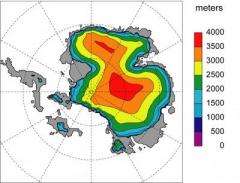CO2 drop and global cooling caused Antarctic glacier to form

(PhysOrg.com) -- Global climate rapidly shifted from a relatively ice-free world to one with massive ice sheets on Antarctica about 34 million years ago. What happened? What changed? A team of scientists led by Yale geologists offers a new perspective on the nature of changing climatic conditions across this greenhouse-to-icehouse transition—one that refutes earlier theories and has important implications for predicting future climate changes.
Detailed in the February 27 issue of Science, their data disproves a long-held idea that massive ice growth in the Antarctic was accompanied by little to no global temperature change.
This report shows that before the Southern Hemisphere ice expansion, high-latitude temperatures were at least 10°C (about 18˚F) warmer than previously estimated and that there was a 5˚C - 10˚C drop in surface-water temperature during the climate transition.
"Previous reconstructions gave no evidence of high-latitude cooling," according to senior author Mark Pagani, professor of geology and geophysics at Yale. "Our data demonstrate a clear temperature drop in both hemispheres during this time."
Their conclusions are based on sea-surface "temperature proxies" - calculations of temperature based on the distribution of specific organic molecules from ancient plankton that only lived at certain temperatures and were later preserved in ocean sediments. These molecules were assayed in ocean cores collected by the Integrated Ocean Drilling Program (IODP) and earlier marine programs that study Earth history by coring deep-ocean sediments and crust around the world.
"Temperatures in some regions, just before the Antarctic glaciers formed, were surprisingly higher than current climate models predicted, suggesting that these models underestimate high-latitude warming under high CO2 conditions," said lead author Zhonghui Liu, Pagani's postdoctoral associate who is now an assistant professor at the University of Hong Kong. Further, he said, the substantial cooling that occurred in both Northern and Southern high latitudes suggests that a decline in CO2 level, rather than a localized change of ocean circulation drove the climate transition.
The ice formed over Antarctica in about 100,000 years, which is an "overnight" shift in geological terms. "Just over thirty-five million years ago, 'poof,' there was an ice sheet where there had been subtropical temperatures before," said Co-author Matthew Huber of Purdue University.
Another theory refuted by this study is the notion that ice-expansion also occurred in the Northern Hemisphere during this time — a supposition poorly supported by physical evidence of glacier formation in that region, say the Yale scientists.
There are about 70 meters of vertical sea level rise represented in the ice sheets of Antarctica. And, there are many questions regarding the glacier's stability, the temperature thresholds that would cause radical glacier melting, and the rate at which it would change, according to Pagani. "Our findings point to the difficulty of modeling accurate temperatures under higher CO2 in this critical region."
Provided by Yale University




















